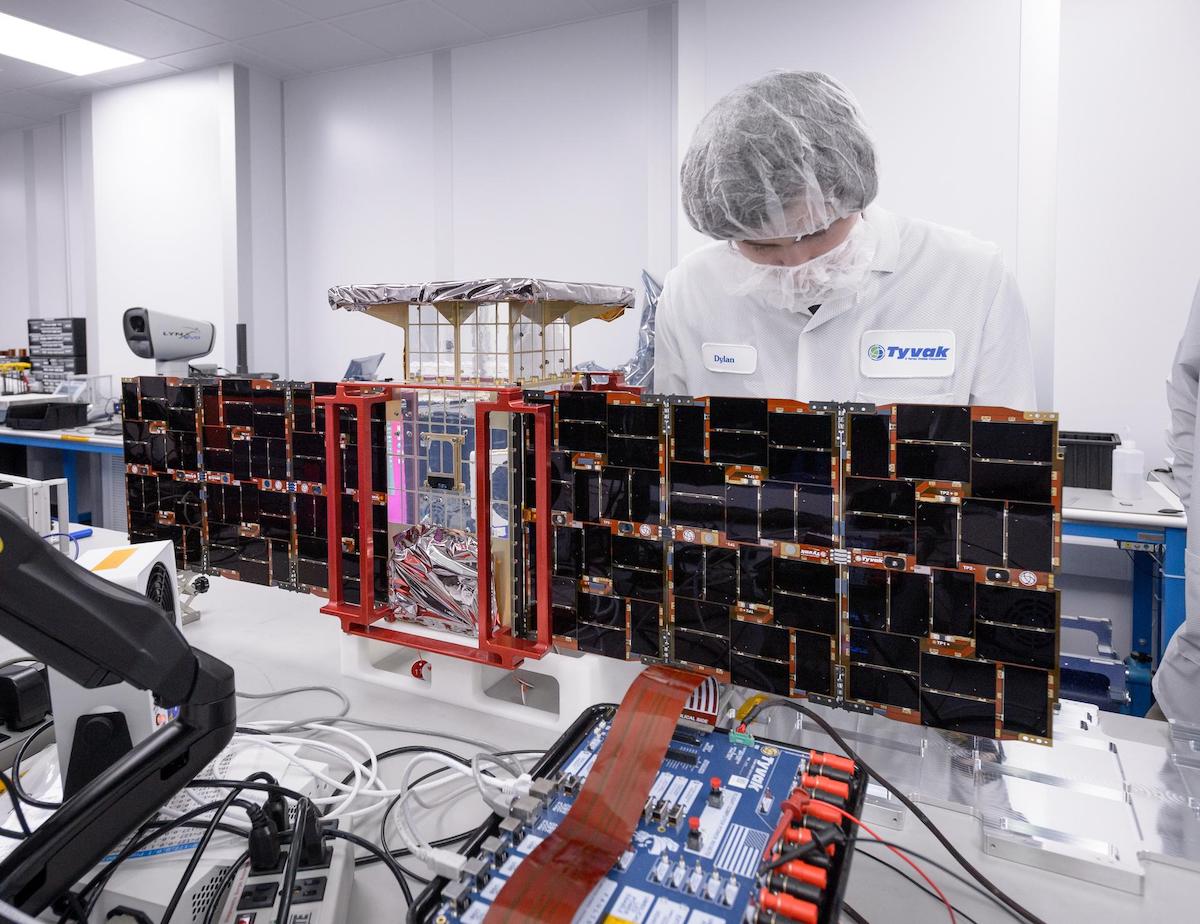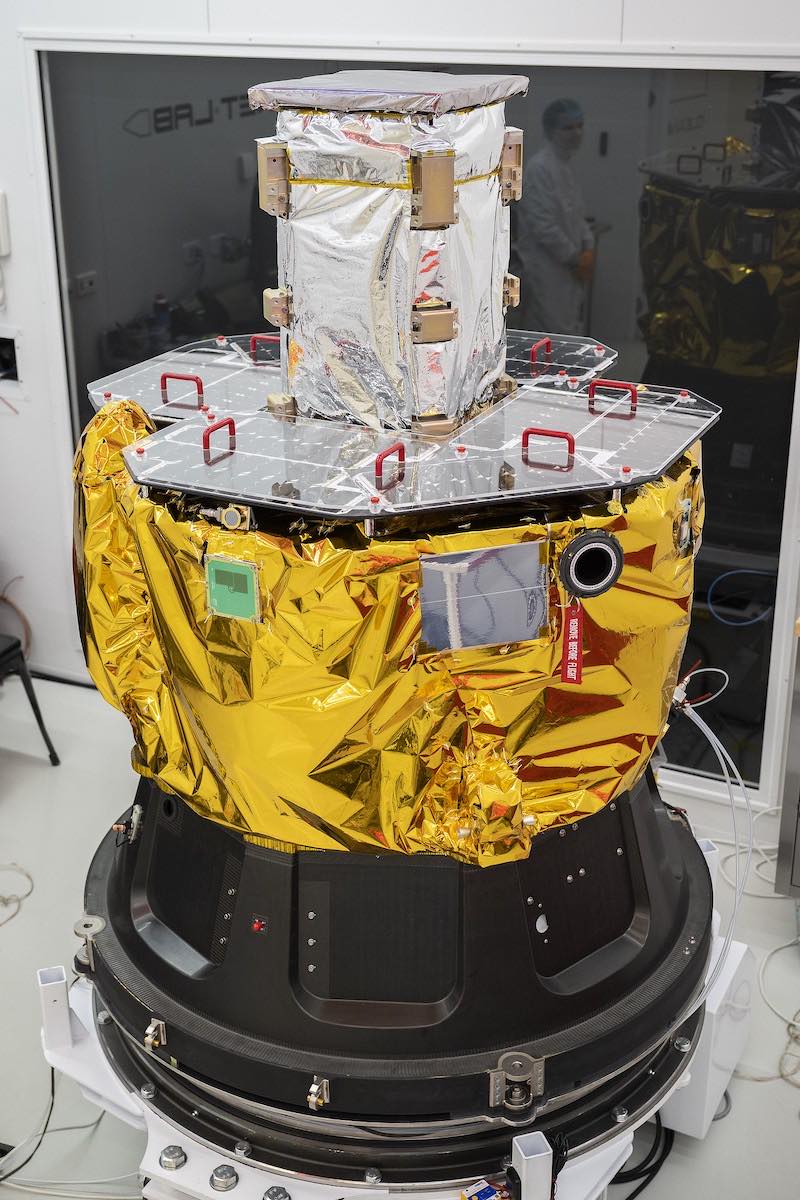Space News & Blog Articles
CubeSat launches on scouting mission for NASA’s Artemis moon program
 Rocket Lab’s Electron launcher fires off the pad in New Zealand with NASA’s CAPSTONE mission. Credit: Rocket Lab
Rocket Lab’s Electron launcher fires off the pad in New Zealand with NASA’s CAPSTONE mission. Credit: Rocket Lab
NASA’s $30 million CAPSTONE mission lifted off Tuesday on a Rocket Lab launcher from New Zealand, departing Earth on a circuitous but fuel-efficient four-month journey toward a halo orbit around the moon to test technologies and operations for the Artemis moon program.
The CAPSTONE mission is modest in scale but opens a new chapter in small satellite technology and is the first new spacecraft to launch under the umbrella of the Artemis program, NASA’s effort to return astronauts to the moon for the first time since 1972.
“CAPSTONE is a pathfinder in many ways, and it will demonstrate several technology capabilities during its mission timeframe while navigating a never-before-flown orbit around the moon,” said Elwood Agasid, project manager for CAPSTONE at NASA’s Ames Research Center in California’s Silicon Valley.
The 55-pound (25-kilogram) spacecraft took off from Rocket Lab’s commercial spaceport on Mahia Peninsula in New Zealand at 5:55:52 a.m. EDT (0955:52 GMT) Tuesday, riding the company’s Electron launcher through the atmosphere on a course east over the Pacific Ocean.
Nine kerosene-fueled engines powered the 59-foot-tall (18-meter) Electron booster off the pad at Rocket Lab’s Launch Complex 1B on the North Island of New Zealand. The mission marked the 27th flight by Rocket Lab’s Electron launcher, and the company’s first mission heading for a destination beyond low Earth orbit.
The Electron’s second stage fired its single engine about two-and-a-half minutes into the mission, then deployed the CAPSTONE spacecraft and Lunar Photon space tug developed by Rocket Lab. The Lunar Photon power and propulsion module fired two times to begin a series of maneuvers to send the CAPSTONE mission on a trajectory toward the moon.
Here’s a replay of the liftoff of Rocket Lab’s Electron launcher from Mahia Peninsula in New Zealand with NASA’s CAPSTONE moon mission. https://t.co/vFr2H2yvef pic.twitter.com/kHgGoGnFRk
— Spaceflight Now (@SpaceflightNow) June 28, 2022
The first two burns by the Photon’s HyperCurie engine placed the CAPSTONE spacecraft into an orbit ranging between 137 miles (220 kilometers) and 668 miles (1,075 kilometers) above Earth. Six more burns over the next six days will gradually raise CAPSTONE’s orbit, with the final burn programmed to send the mission on its path toward lunar orbit.
Unlike the Apollo missions, which reached the moon in three-to-four days, CAPSTONE will take more than four months to reach its target orbit. But CAPSTONE’s journey is more fuel-efficient. The spacecraft will head to a point in space some 800,000 miles (1.3 million kilometers) from Earth, more than three times the distance of the moon.
The CAPSTONE spacecraft will separate from the Lunar Photon carrier about six days into the mission, then perform more course corrections with its own tiny hydrazine thrusters.
CAPSTONE stands for the Cislunar Autonomous Positioning System Technology Operations and Navigation Experiment.
 An engineer at Tyvak Nano-Satellite Systems inspects solar arrays on NASA’s CAPSTONE spacecraft. Credit: NASA/Dominic Hart
An engineer at Tyvak Nano-Satellite Systems inspects solar arrays on NASA’s CAPSTONE spacecraft. Credit: NASA/Dominic Hart
At its farthest point from Earth, the sun’s gravity will exert influence on CAPSTONE’s trajectory, helping naturally guide the spacecraft back toward the moon, where the spacecraft will fire its thrusters to steer into a near rectilinear halo orbit, or NRHO.
CAPSTONE’s arrival in that orbit is timed for Nov. 13.
The halo orbit will take CAPSTONE as close as 1,000 miles (1,500 kilometers) from the moon’s North Pole and as far as 43,500 miles (70,000 kilometers) from the South Pole. Each orbit of the moon will last about six-and-a-half days, according to NASA.
The same type of orbit will be used by NASA’s Gateway mini-space station, an element of NASA’s Artemis program that will serve as a staging base and experiment platform. Astronauts will use the Gateway as a stopover between Earth and the moon.
The CAPSTONE mission will demonstrate the fine maneuvers to nudge a spacecraft into the Gateway’s orbit, which requires only small amounts of fuel to maintain. Spacecraft and lunar landers can enter and exit the orbit with low-impulse thruster burns, and a station in such an orbit will have a continuous communications link with Earth.
A station like the Gateway is needed because the Orion spacecraft, which will carry crews to and from the vicinity of the moon, does not have the ability to maneuver directly into and out of a low-altitude lunar orbit, like the Apollo spacecraft did in the 1960s and 1970s.
A lunar lander departing the Gateway’s orbit will be able to ferry astronauts to the moon’s South Pole, where scientists have discovered water ice in permanently shadowed craters.
The CAPSTONE spacecraft is about the size of a microwave oven. The mission was developed at a cost of $30 million, an unusually low budget for a project of CAPSTONE’s ambition. And the payoff could ripple across the commercial launch and small satellite industries, space science, and NASA’s Artemis program to return astronauts to the surface of the moon.
“Part of what makes this mission compelling, from my perspective, is how it is pushing forward our desire to increase the pace of space exploration, the expansion of commercial space capabilities, helping support not just our major human exploration program, but also helping expand the capability of small missions to reach new destinations and operate in challenging new environments,” said Chris Baker, a manager in NASA’s small spacecraft technology program.
The mission is funded by NASA, and the CAPSTONE spacecraft is owned and managed by a small Colorado company named Advanced Space. Rocket Lab is responsible for launching the mission, Tyvak Nano-Satellite Systems built the spacecraft, Stellar Exploration developed CAPSTONE’s propulsion system, and Tethers Unlimited supplied radio systems.
One of the two prime objectives for the CAPSTONE mission is to demonstrate the maneuvers required to reach the unique near rectilinear halo orbit, where gravitational influences from the Earth and the moon can effect the trajectory of a spacecraft. No mission has ever flown in this specific type of orbit.
 This graphic illustrates the increasing altitude of the phasing orbits around Earth and the trans-lunar trajectory for NASA’s CAPSTONE mission to reach the near rectilinear halo orbit. Credit: Rocket Lab
This graphic illustrates the increasing altitude of the phasing orbits around Earth and the trans-lunar trajectory for NASA’s CAPSTONE mission to reach the near rectilinear halo orbit. Credit: Rocket Lab
In the halo orbit, CAPSTONE will be primarily influenced by Earth’s gravity. But the tug from the moon takes over on the day the spacecraft is closest to the lunar surface.
This type of orbit “has the benefit of the low energy to get into and low energy to get out of,” Baker said. “But you are then now kind of riding this balance point between the gravitational pull of the Earth and the gravitational pull of the moon.”
Engineers want to learn about the “operational realities” of how to stay in the elongated orbit, while accounting for the ever-changing positions of the Earth and the moon, said Bradley Cheetham, CEO of Advanced Space and principal investigator for the CAPSTONE mission.
Future Artemis crew missions to the moon will travel to the halo orbit quicker than CAPSTONE, covering the quarter-million-mile distance in as few as five days, according to Nujoud Merancy, chief of the exploration mission planning office at NASA’s Johnson Space Center in Houston.
If the CAPSTONE mission runs into problems, Merancy said NASA will move forward with the Gateway and other elements of the Artemis program without data from the pathfinder probe.
Rocket Lab won the $10 million contract to launch the CAPSTONE mission in 2020, and originally intended to send the spacecraft aloft from a new launch site at Wallops Island, Virginia. But delays in certifying the Electron rocket’s range safety system has prevented Rocket Lab from starting service from Virginia, forcing officials to move the CAPSTONE launch to the company’s New Zealand spaceport already in operation.
The Lunar Photon tug designed to do much of CAPSTONE’s lifting is an upgraded version of the Photon platform Rocket Lab developed as an experiment platform for low Earth orbit. The Photon is an evolution of Rocket Lab’s kick stage originally built to place Electron rocket payloads into their final orbit for deployment.
“Doing a mission like this is no easy task,” said Peter Beck, founder and CEO of Rocket Lab, which was established in New Zealand and is now based in Long Beach, California. “What I’m most excited about is we’re really, from Rocket Lab’s perspective at least, bringing a anew capability to go very far and do exciting things in deep space at a budget and a timeline that was really never seen before.”
After reaching the moon, the CAPSTONE mission will perform experiments in collaboration with NASA’s Lunar Reconnaissance Orbiter, which flies in an orbit closer to the moon. The two spacecraft will establish a radio link with each other to test a deep space navigation capability.
Satellites close to Earth use the Space Force’s GPS satellites to determine their exact position. Probes traveling to more distant destination require assistance from the ground, using radio ranging technology for navigation.
 NASA’s CAPSTONE spacecraft is pictured no top of Rocket Lab’s Photon tug, which will give the mission a boost toward the moon. Credit: Rocket Lab
NASA’s CAPSTONE spacecraft is pictured no top of Rocket Lab’s Photon tug, which will give the mission a boost toward the moon. Credit: Rocket Lab
The CAPSTONE spacecraft will send a ranging tone to LRO, which will beam the signal back to CAPSTONE. Software on the CAPSTONE spacecraft will use the signal to measure the distance to LRO, and determine how the distance has changed over time. From that, the computer on CAPSTONE can estimate the spacecraft’s position.
The mission also carries a chip-scale atomic clock to assist in navigation, giving the spacecraft another source of information to estimate its position in space.
“CAPSTONE, at its core, is a flight test, and it’s a flight test of multiple capabilities,” Baker said. “We have these great onboard experiments, but the capabilities I think we’re demonstrating are well beyond just those.”
The small spacecraft also carries a camera to snap pictures of the moon, although the image-taking is not part of the primary goals for the mission.
“Why would you go to the moon without a camera, right?” Cheetham said.
This email address is being protected from spambots. You need JavaScript enabled to view it. the author.
Follow Stephen Clark on Twitter: @StephenClark1.
When you subscribe to the SpaceZE News Feed, we will send you an e-mail when there are new updates on the site so you wouldn't miss them.

